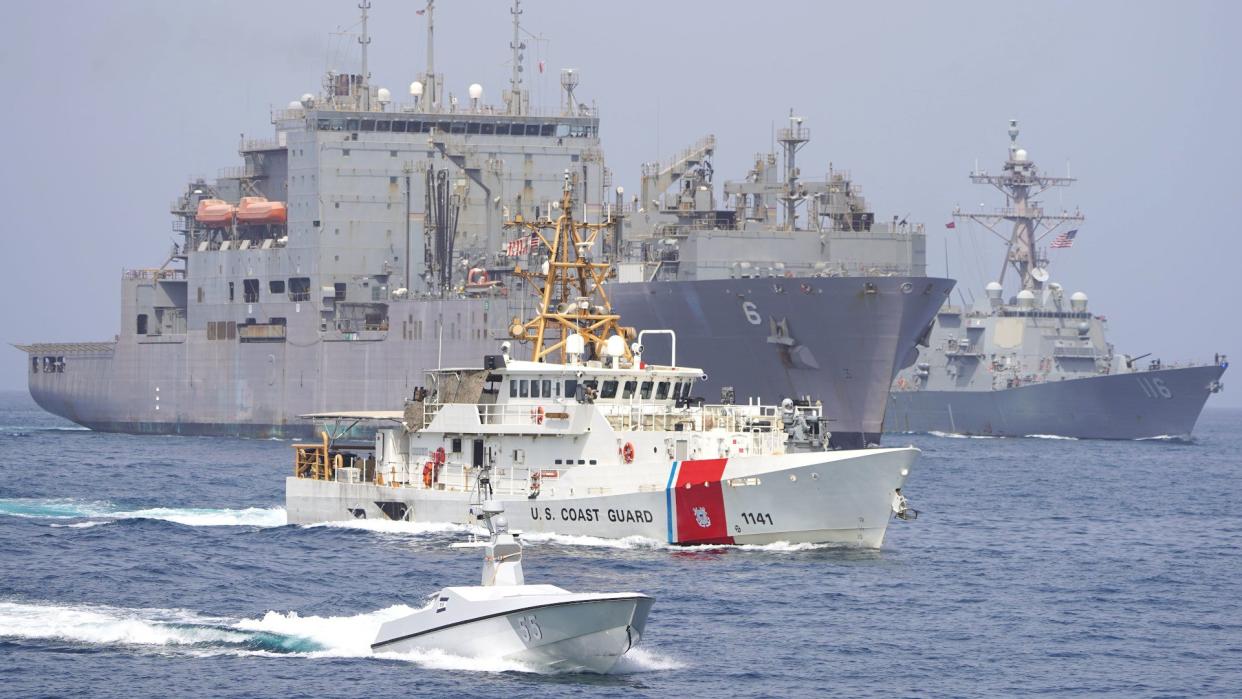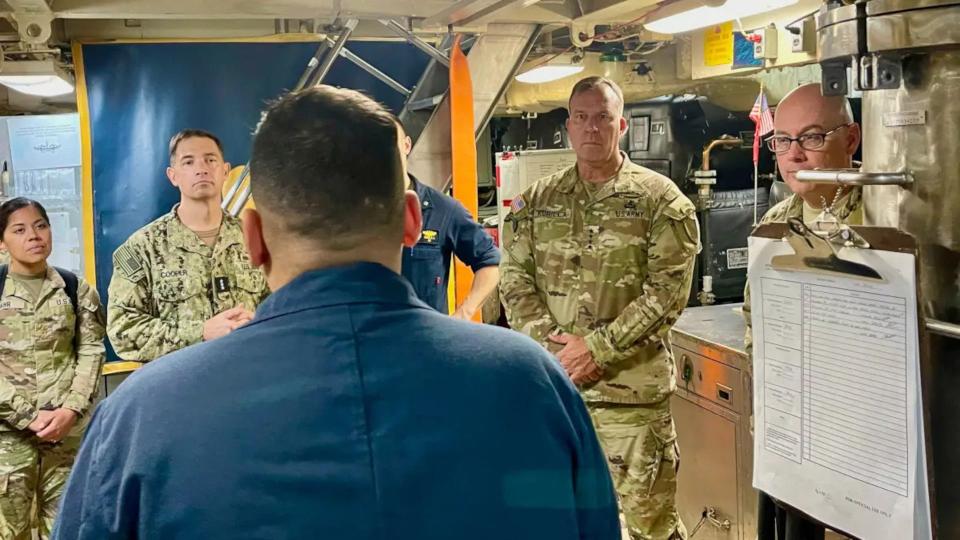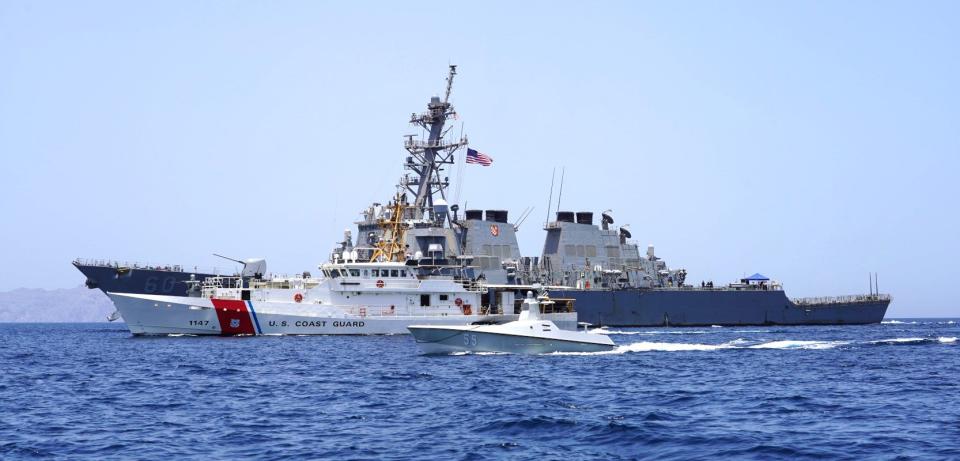Drone Boat Leading Navy Ships In The Strait Of Hormuz A Sign Of Things To Come

A semi-autonomous drone boat recently helped escort a number of U.S. naval vessels during a recent high-profile transit through the volatile Strait of Hormuz linking the Persian Gulf and the Gulf of Oman.
The group of ships that were part of the transit included the U.S. Navy's Arleigh Burke class destroyer USS Thomas Hudner carrying senior commanders. For years now, the service has been using this particular region as a place to test and evaluate new uncrewed platforms through real-world missions, such as keeping watch on Iranian forces and helping to guard high-value friendly assets.
The Navy released the picture, seen at the top of this story, of the L3Harris Arabian Fox uncrewed surface vessel (USV) out in front of the other ships in the group as they passed westward through the Strait of Hormuz into the Persian Gulf on August 6 earlier today. Beyond USS Thomas Hudner, the Navy's Lewis and Clark class cargo ship USNS Amelia Earhart and the U.S. Coast Guard's Sentinel class cutter USCGC Charles Moulthrope are also seen in the image.
U.S. Central Command (CENTCOM) had announced yesterday that its commander, U.S. Army Gen. Michael Kurilla, as well as Navy Vice Adm. Brad Cooper, had joined the Thomas Hudner as it made the transit. Cooper is head of Naval Forces Central Command (NAVCENT) and U.S. Fifth Fleet. This is not the first time Kurilla and Cooper have done something like this. The two officers visited the Ohio class nuclear ballistic missile submarine USS West Virginia somewhere in the Arabian Sea last year, which was a highly unusual disclosure of that boat's presence in the region at all.

Very similar to the Maritime Autonomy Surface Testbed 13 (MAST-13) that L3Harris built for the Defense Science and Technology Laboratory (Dstl) in the United Kingdom, Arabian Fox is a 13-foot-long USV reportedly capable of reaching speeds up to 40 knots and having a maximum at-sea endurance of 36 hours. It is equipped with an MX-10MS sensor turret with electro-optical and infrared full-motion video cameras, as well as robust communication and artificial intelligence (AI) enabled control suites.
https://www.youtube.com/watch?v=D5fQ_sfxPvs
Arabian Fox can sail semi-autonomously along set routes and features an autonomous collision avoidance capability that allows it to sail safely together in close proximity to other vessels. During the USV's time in the Middle East already, L3Harris has demonstrated the ability to control it using line-of-sight datalinks, via a mesh network made up of various assets.
Arabian Fox has already made multiple transits of the Strait of Hormuz alongside other U.S. naval vessels this year, but the one on August 6 was particularly significant given the presence of Gen. Kurilla and Vice Adm. Cooper.

Helping to provide additional situational awareness as part of a larger group of naval vessels, especially high-value assets like warships carrying top officials, is fully in line with the kinds of mission sets that the Navy has been looking at for smaller USVs. The additional set of 'eyes' that a platform like Arabian Fox can provide is especially relevant in the Strait of Hormuz where the potential threat picture is diverse and there is limited space to maneuver.
If Iran were to try to block access to the Strait of Hormuz, it would be able to call upon an arsenal that includes missiles, kamikaze drones, and naval mines. In addition to fleets of small crewed fast attack boats that they can use to swarm larger vessels, the Iranians also have remotely operated suicide boats. This is a capability they have demonstrated as a real threat through their assistance to Houthi rebels in Yemen. The value of explosive-laden drone boats has only been underscored more recently by Ukraine's active use of them against Russian ships and other targets.
Historically, smaller crewed patrol boats, which the Navy has been steadily divesting, have provided this kind of close escort in the Strait of Hormuz, often together with larger warships, and similar waterways elsewhere around the world. Close-in defense is particularly important when it comes to countering swarms of small boats, crewed or uncrewed. When it comes to defending against drone boats in the future, it may well be the case that the best option is the employment friendly ones.
Intelligence, surveillance, and reconnaissance (ISR) type missions have also been a key focus for the Navy's Task Force 59, to which Arabian Fox is currently assigned. Created in 2021, Task Force 59 has been using strategic waterways around the Middle East as real-world environments to test and evaluate new uncrewed platforms, including aerial drones, USVs, and uncrewed underwater vehicles (UUV), as well as related AI-driven technologies. The unit, which other branches of the U.S. military are now emulating, has also been contributing to real missions, like helping monitor malign Iranian activities. This has already led to direct altercations with Iranian forces, including one incident where they briefly seized a pair of the task force's Saildrone USVs in the Red Sea last year.
https://www.youtube.com/watch?v=417vEblGm1o
"We have said all along that Iran poses the most pressing threat in the region. There have been a number of growing threats, from a maritime perspective, facing commercial vessels that are transiting regional waters, and those threats are well reported," Navy Cdr. Timothy Hawkins, a spokesperson for NAVCENT and Fifth Fleet, told The War Zone in an interview earlier this year. "And Iran has often been behind them. That's a common thread."
"That's why we feel that strengthening our existing partnerships and accelerating innovation are key. And those two things are intertwined," he continued. "And those two things are reflected in our establishment of Task Force 59 and how we have moved out and are integrating these new technologies."
The Strait of Hormuz is a particularly strategic waterway and potentially dangerous chokepoint. Nearly 90 percent of all oil produced in the Persian Gulf, which accounts for around 20 to 30 percent of all global oil exports, exits the region via the Strait. Iran, which controls one side of the Strait, routinely threatens to blockade it in retaliation for actions taken by the United States and others.
Just in the past month or so, the U.S. military has significantly reinforced its presence in this part of the world, including with the deployment of the USS Thomas Hudner and F-35 and F-16 fighters. This is in response to a string of seizures and attempted seizures of commercial vessels by Iranian forces earlier this year. This includes an incident last month where Iranian personnel opened fire on a commercial tanker off the coast of Oman, but where American naval forces intervened to prevent its capture. No one on the tanker was injured and it suffered no significant damage, according to the Navy.
https://www.youtube.com/watch?v=OFYGbTNBepw
A Navy Amphibious Ready Group carrying a Marine Expeditionary Unit has now also arrived in the region for a scheduled deployment. There have been reports that the U.S. government is considering making Marines available to guard commercial vessels by deploying aboard them.
Task Force 59's work has impacts beyond the Middle East. The unit's work is helping the Navy to explore and refine its still-evolving concepts of operations for integrating more robust USVs and UUVs into routine operations, as well as just gain relevant real-world experience in this regard.
The Navy, as well as the Marine Corps, have a stated interest in fielding larger numbers of increasingly diverse USVs and UUVs that can take on a wide array of missions beyond ISR, including electronic warfare and stand-off strike, and do so at relatively low cost. These platforms also have the benefit of being able to operate well forward of crewed vessels, helping to keep the latter further away from known and unknown threats.
The Navy has already test-fired a multi-purpose SM-6 missile, which can be employed against aerial and surface threats, from a containerized launch system mounted on a larger USV. The Marines are also working to acquire a fleet of Long Range Unmanned Surface Vessels (LRUSV) that can perform ISR missions and be armed with loitering munitions for launching precision strikes on targets at sea or ashore.
https://www.youtube.com/watch?v=L6F49rv-Dxw
At the same time, significant questions remain about exactly how the Navy, especially, will proceed with its uncrewed plans. The service has gotten pushback from Congress in recent years over concerns it has not fully fleshed outs how it expects to use various tiers of USVs and UUVs.
Still, USVs like Arabian Fox helping to escort larger groups of U.S. Navy ships look set to be an increasingly common sight, especially in congested and potentially dangerous waterways like the Strait of Hormuz.
Contact the author: joe@thedrive.com

